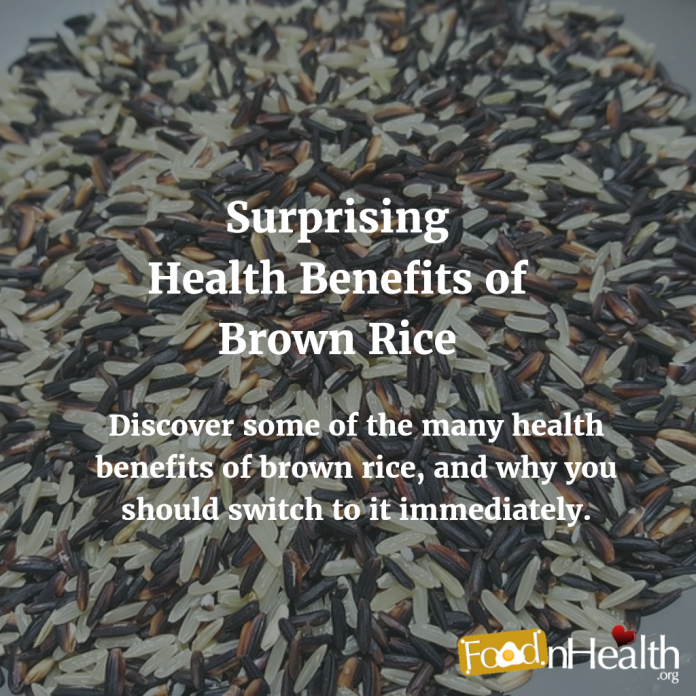Over half of the world’s population use rice as a staple in their diet. Traditionally, brown rice was associated with the food of the poor or eaten during war time. Brown rice compared to white rice has a slight nutty flavor, is a little chewier and has a shorter shelf life.
Brown rice is turned into white rice when the outer bran layer is removed. When the bran layer is removed, the rice is white in color and is also lower in nutritional value.
Brown rice is higher in fiber, vitamins and minerals compared to white rice. Therefore, eating brown rice and other whole grains over refined grains like white rice is considered better for health.
Brown rice is associated with potential health benefits such as: lowering risk for type 2 diabetes, cardiovascular disease and also lower risk for certain cancers.
The health benefits associated with brown rice intake is from the fiber, vitamins, minerals, antioxidants and other unique components in brown rice.

The US Dietary Guidelines suggests substituting whole grains in place of refined grains and making at least half your grain intake (about 3 ounce equivalents) from whole grains.
Good source of magnesium and manganese
The bran and germ layer in grains contain most of the nutrients. The white part of grains, the endosperm, has little nutritional value and is the main component of white rice. Brown rice contains the bran and germ layer.
A cup of brown rice provides about 216 calories, 5 grams of protein, 45 grams of carbohydrate, 3.5 grams of fiber and just a little under 2 grams of fat. One cup of brown rice also provides 21% DV magnesium, 88% DV manganese and B vitamins.
Magnesium is needed for over 300 enzymatic processes in the body including: protein synthesis, muscle contraction, nerve signaling and for energy production.
Data suggests most people do not meet the recommended daily intake of magnesium. Therefore, adding brown rice to the diet can help meet magnesium recommended intake of 420 mg for adult men and 320 mg for adult women.
Manganese is used in enzymatic reactions with metabolism, bone health, wound healing and acts as an antioxidant in the body.
Low dietary manganese intakes have been associated with chronic diseases. Therefore, eating manganese rich foods, like brown rice, may help lower risk for several chronic diseases.
Antioxidants in brown rice and disease prevention
Fruits and vegetables are usually associated as being rich sources of antioxidants. While this is true, whole grains like brown rice are also contributors of antioxidants in the diet.
A 2016 review from Critical Reviews in Food Science and Nutrition summarized the antioxidant levels in whole grains including brown rice. Researchers concluded consuming whole grains can provide significant health benefits for disease prevention because of their high levels of antioxidants.
Lower risk for type 2 diabetes
According to WebMD, research suggests replacing white rice with brown rice may help lower risk for type 2 diabetes.
Eating two or more servings of brown rice per week has been shown to be associated with a reduced risk for type 2 diabetes.
However, eating five or more servings of white rice per week was associated with an increased risk of type 2 diabetes.
Up to 70% of rice eaten in the US is white rice. Simply switching to brown rice instead of white rice could have a positive and significant impact on type 2 diabetes risk.
Lower risk for cardiovascular disease
A 2004 study gathered data from over 40,000 adult men over 14 years. Researchers found there was an inverse association between whole grain intake and cardiovascular disease. The nutrients found in the bran and germ layer of whole grains, which are removed in refined grains like white rice, provide nutrients in the diet that may lower risk for cardiovascular disease.
Another 2014 study compared the effects of white rice compared to brown rice had on inflammatory markers and cardiovascular disease risk in overweight or obese women.
Participants were either put on a diet containing brown or white rice for 6 weeks. Then, after a 2 week washout period, participants switched groups for another 6 weeks.
Researchers concluded brown rice in the diet could be helpful for reducing inflammatory markers and cardiovascular risk factors. The brown rice diet compared to the white rice diet should a significant difference in weight reduction, waist circumference and CRP blood levels (a marker of inflammation).
Brown rice and cancer risk
Observations have noted Asian cultures typically have lower incidences of breast and colon cancer compared to Western cultures. Asian cultures also include rice as a main staple in their diet. Therefore, some components in rice may offer protection against these cancers.
Because brown rice contains higher antioxidant levels compared to white rice, it may offer more cancer fighting nutrients compared to white rice.
Researchers in a 2000 study investigated colon and breast cancer tumor suppressive factors in rice. Researchers concluded brown rice and rice bran contain compounds that may be advantageous for cancer protection.
Brown rice and rice bran had significantly higher levels of compounds that may offer cancer protection compared to white rice.
While this study suggests brown rice may provide nutrients that protect against certain cancers, more research is needed. Many factors can influence cancer risk, and there may be other lifestyle factors in Asian cultures that offer protection against certain cancers.
Conclusion
Brown rice is a whole grain that is a source of fiber, vitamins, minerals and antioxidants. These nutrients, and maybe others, can offer many health benefits. Brown rice has been shown to be associated with lowered risk for cardiovascular disease and type 2 diabetes. Brown rice’s antioxidants may also protect cells from damage from carcinogens and may help lower risk for certain cancers.
Replacing whole grains for refined grains is recommended for overall health. The bran and germ layer in grains provide many nutrients that are stripped away in the process of making refined grains.























